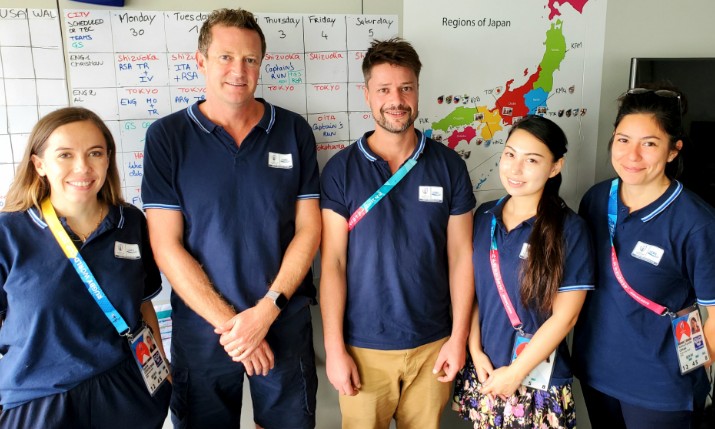Live from the Rugby World Cup: IGBS production extends beyond the pitch

(l-to-r) Sylvie Costa Dias, Tim Lacy, Joffray Procureur, Angella Tachibana, and Amina Omar oversee the production efforts of seven ENG crews and more at the Rugby World Cup IBC.
Just how much have the Rugby World Cup production efforts for rights holders grown since 2015? Yes, International Games Broadcast Services (IGBS), the joint effort between HBS and IMG Media, has greatly increased the number of feeds and content around the live matches.
But there are also 40 people working in both Japan and IMG Media’s facility in Stockley Park outside of London that are creating feature stories, half-hour and hour-long shows, packaged highlights, and social media content that is ready for use by rights holders. The last World Cup in 2015, by contrast, had no one from the host broadcast team working on that type of content.
Tim Lacy, IMG Media, executive producer for the Rugby World Cup, oversees a team of 40 that includes seven three-man ENG crews that are in the country and covering various teams; a highlights team of four people (two editors, a producer, and voice-over talent); an additional content team of three editors, a graphics creator, and two producers; four social media content creators; and three editors and three producers in Stockley Park outside London.
“All that content comes back to a central server and is picked up in London by our preview team that is putting together a match-day preview. But then we also have editors here doing additional content that is also going to those preview shows and other elements that sit in the server for broadcasters.”
At the core of all the efforts is an EVS server that can store 2,000 hours of content. The content from the seven ENG crews (only four will be in the country after the group phase ends) is ingested via ingest points at each of the stadiums and occasionally team hotels. That content includes fully produced content as well as a lot of raw material like interviews, press conferences, and video of teams in the community as well as B-roll and colour material for packages that are created at the IBC or in Stockley Park.
“We can’t have one per team, unfortunately, so we have them moving around to cover off all the media opportunities that are available,” says Lacy. “All that content comes back to a central server and is picked up in London by our preview team that is putting together a matchday preview. But then we also have editors here doing additional content that is also going to those preview shows and other elements that sit in the server for broadcasters.”
One of the trickier elements is green-screen shots of players who are replacing injured players on a team roster. Those shots are a priority and already 16 players have been replaced.
“It definitely impacts on the rest of the schedule,” says Lacy.

An EVS server at the IBC holds up to 2,000 hours of Rugby World Cup content.
The content from the ENG crews is complemented by plenty of match feeds and iso cameras as well as content from the teams. Some of the teams have their own crews and send over their footage. New Zealand, Australia, England, and Ireland lead the way when it comes to submitting additional content.
“That’s a big process that World Rugby is managing,” says Lacy.
The production team is focused on creating video packages that can make a difference for rights holders who are looking to create coverage of the event beyond the matches. For host broadcasters, especially dedicated units like IGBS, it’s one of the important advantages they offer versus an event whose host coverage is handled by a domestic rights holder.
For example, each day a 24-minute daily highlight show is created for matches that day and it is 24-minutes long regardless of whether there is one match or four matches. The team also creates a weekly 48-minute recap and at the end of the tournament two highlight videos, a one-hour and a two-hour version, will be available.
In addition, there are feature stories, top five clips, and other shorter elements that can be dropped into a rights holders coverage.
New this year is the Rugby Interface (TRI), a browser-based interface that allows rights holders around the globe (and Japan) to dip into a wealth of content resources. Regardless of whether the rights holder is on-site at the IBC or thousands of miles away, the experience, and content availability is the same.
Peter Radmacher, HBS, multimedia manager, says the TRI system offers a number of enhancements including the ability to set in and out points within a larger file so that the most desired content is easily extractable. It also has subtitles and a transcript of, for example, a press conference. By selecting the text within the transcript the user can immediately jump to the matching video clip.
“All live feeds and press conferences are also available on the TRI,” he adds.

The TRI brower-based system makes it easy for rights holders to find the content they want.
The TRI is tied to an EVS XT3 server with more than 2,000 hours of capacity at the IBC. That server includes everything from match feeds to iso feeds and all of the incoming content from the ENG teams, etc.
The TRI system allows rights holders both on site and around the world to dive into the server and grab the content they need via ASPERA FASP transfer.
“It can also be used with Signiant or File Catalyst but for this event we are using Aspera,” says Radmacher.
At the end of the tournament all of the match feeds and isos will be offload to LTO tapes so that World Rugby can add it to their LTO tape library back in Dublin, Ireland.

